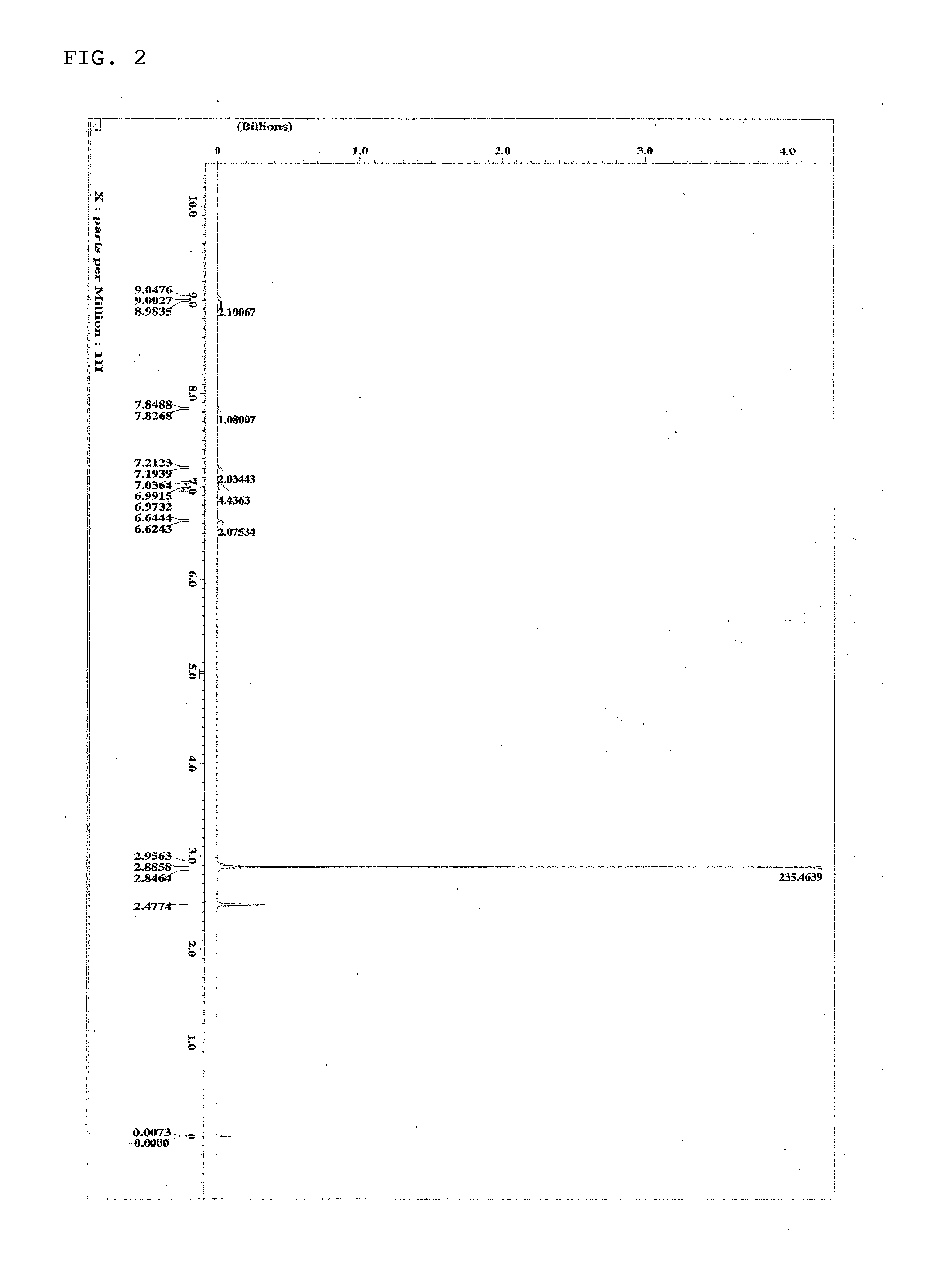Compound having diazatriphenylene ring structure, and organic electroluminescent device
a diazatriphenylene ring and organic technology, applied in thermoelectric devices, group 3/13 element organic compounds, group 5/15 element organic compounds, etc., can solve the problem of not getting high quantum yield in many cases in general, and achieve stable thin-film state, improve heat resistance, and delay fluorescence
- Summary
- Abstract
- Description
- Claims
- Application Information
AI Technical Summary
Benefits of technology
Problems solved by technology
Method used
Image
Examples
example 1
Synthesis of 6,11-bis(phenoxazin-10-yl)-1,4-diazatriphenylene (Compound 1)
[0112]9,10-Phenanthrenequinone (10 g) and concentrated sulfuric acid (100 mL) were added into a nitrogen-substituted reaction vessel and aerated with nitrogen. N-bromosuccinimide (18 g) was added, and the mixture was stirred at a room temperature for 2 hours. After water (50 mL) was added, the mixture was added into ice water (600 mL). A precipitated solid was collected by filtration and washed under heat and reflux with ethyl acetate (100 mL) followed by vacuum drying to obtain a yellow solid of 2,7-dibromo-9,10-phenanthrenequinone (yield 73%).
[0113]2,7-Dibromo-9,10-phenanthrenequinone (2.0 g), ethanol (30 mL), and ethylenediamine (10 mL) were added into a nitrogen-substituted reaction vessel and aerated with nitrogen. The mixture was heated while being stirred, and refluxed for 2 hours. Acetic acid (50 mL) was added, and the mixture was further refluxed for 16 hours. After left to cool, a precipitated solid ...
example 2
Synthesis of 6,11-bis(phenothiazin-10-yl)-1,4-diazatriphenylene (Compound 2)
[0117]6,11-Dibromo-1,4-diazatriphenylene synthesized in Example 1 (2.0 g), potassium carbonate (3.0 g), phenothiazine (3.2 g), tri-tert-butylphosphine (0.1 g), and toluene (60 mL) were added into a nitrogen-substituted reaction vessel and aerated with nitrogen. After deaeration under reduced pressure, palladium acetate (60 mg) was added, and the mixture was heated while being stirred, and refluxed for 20 hours. After left to cool, a precipitated solid was collected by filtration, washed under heat and reflux with methanol, and further washed under heat and reflux with acetone, followed by vacuum drying to obtain a gray solid of 6,11-bis(phenothiazin-10-yl)-1,4-diazatriphenylene (Compound 2; yield 76%).
[0118]The structure of the obtained gray solid was identified by NMR. The 1H-NMR measurement result is shown in FIG. 2.
[0119]1H-NMR (DMSO-d6) detected 24 hydrogen signals, as follows. δ (ppm)=9.05 (2H), 8.99 (4...
example 3
Synthesis of 6,11-bis(9,9-dimethylacridan-10-yl)-1,4-diazatriphenylene (Compound 4)
[0120]6,11-Dibromo-1,4-diazatriphenylene synthesized in Example 1 (0.9 g), potassium carbonate (0.9 g), 10-H-9,9-dimethylacridan (1.0 g), tri-tert-butylphosphine (0.05 g), and toluene (20 mL) were added into a nitrogen-substituted reaction vessel and aerated with nitrogen. After deaeration under reduced pressure, palladium acetate (30 mg) was added, and the mixture was heated while being stirred, and refluxed for 18 hours. After left to cool, a precipitated solid was collected by filtration, washed under heat and reflux with methanol, and further washed under heat and reflux with acetone, followed by purification by recrystallization with 1,2-dichlorobenzene to obtain a gray powder of 6,11-bis(9,9-dimethylacridan-10-yl)-1,4-diazatriphenylene (Compound 4; yield 30%).
[0121]The structure of the obtained gray powder was identified by NMR. The 1H-NMR measurement result is shown in FIG. 3.
[0122]1H-NMR (DMSO...
PUM
| Property | Measurement | Unit |
|---|---|---|
| external quantum efficiency | aaaaa | aaaaa |
| external quantum efficiency | aaaaa | aaaaa |
| temperature | aaaaa | aaaaa |
Abstract
Description
Claims
Application Information
 Login to View More
Login to View More - R&D
- Intellectual Property
- Life Sciences
- Materials
- Tech Scout
- Unparalleled Data Quality
- Higher Quality Content
- 60% Fewer Hallucinations
Browse by: Latest US Patents, China's latest patents, Technical Efficacy Thesaurus, Application Domain, Technology Topic, Popular Technical Reports.
© 2025 PatSnap. All rights reserved.Legal|Privacy policy|Modern Slavery Act Transparency Statement|Sitemap|About US| Contact US: help@patsnap.com



